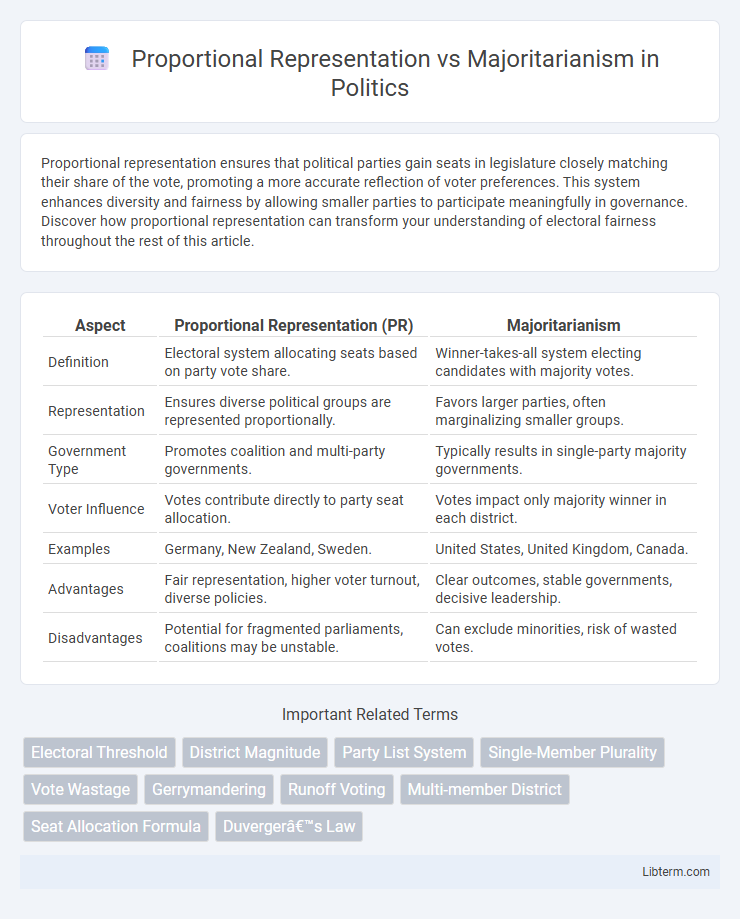Proportional representation ensures that political parties gain seats in legislature closely matching their share of the vote, promoting a more accurate reflection of voter preferences. This system enhances diversity and fairness by allowing smaller parties to participate meaningfully in governance. Discover how proportional representation can transform your understanding of electoral fairness throughout the rest of this article.
Table of Comparison
| Aspect | Proportional Representation (PR) | Majoritarianism |
|---|---|---|
| Definition | Electoral system allocating seats based on party vote share. | Winner-takes-all system electing candidates with majority votes. |
| Representation | Ensures diverse political groups are represented proportionally. | Favors larger parties, often marginalizing smaller groups. |
| Government Type | Promotes coalition and multi-party governments. | Typically results in single-party majority governments. |
| Voter Influence | Votes contribute directly to party seat allocation. | Votes impact only majority winner in each district. |
| Examples | Germany, New Zealand, Sweden. | United States, United Kingdom, Canada. |
| Advantages | Fair representation, higher voter turnout, diverse policies. | Clear outcomes, stable governments, decisive leadership. |
| Disadvantages | Potential for fragmented parliaments, coalitions may be unstable. | Can exclude minorities, risk of wasted votes. |
Introduction to Proportional Representation and Majoritarianism
Proportional Representation (PR) allocates legislative seats based on the percentage of votes each party receives, ensuring a more accurate reflection of voter preferences. Majoritarianism, alternatively, awards seats to candidates or parties that secure the most votes in single-member districts, often resulting in a winner-takes-all outcome. PR promotes multi-party collaboration and diverse representation, while majoritarianism tends to favor stable governments and clear electoral mandates.
Defining Proportional Representation
Proportional Representation (PR) is an electoral system designed to allocate seats in legislative bodies in proportion to the number of votes each party receives, ensuring minority parties gain representation reflective of their voter support. Unlike Majoritarianism, which typically awards victory to the candidate or party with the most votes in a district, PR minimizes wasted votes and promotes multiparty inclusion. This system enhances political diversity and often leads to coalition governments by translating vote share directly into legislative seats.
Understanding Majoritarian Electoral Systems
Majoritarian electoral systems concentrate on awarding representation to candidates or parties that secure the majority of votes in an election, often through single-member districts or first-past-the-post methods. This system typically results in a clear winner, fostering stable governments but potentially underrepresenting smaller parties and minority interests. Understanding majoritarianism involves analyzing its impact on political competition, voter behavior, and the overall structure of legislative bodies.
Historical Evolution of Both Systems
Proportional Representation (PR) emerged in the late 19th century as a response to the limitations of Majoritarianism, aiming to reflect a broader spectrum of voter preferences through multi-member districts and party lists. Majoritarianism, rooted in British parliamentary traditions, has dominated since the 18th century with single-member districts and winner-takes-all elections, emphasizing clear majorities. The historical evolution shows PR's rise alongside democratization and social movements seeking inclusivity, while Majoritarianism remains prevalent in established democracies valuing stability and decisive governance.
Key Differences: Proportional vs Majoritarian Voting
Proportional representation ensures that political parties gain seats in proportion to the total votes they receive, promoting a diverse legislature that reflects the electorate's range of preferences. Majoritarian voting systems allocate seats to candidates or parties that receive the most votes in individual districts, often resulting in a winner-takes-all outcome that favors larger parties. The key difference lies in proportional systems fostering multi-party representation, while majoritarian systems tend to create stable governments dominated by one or two parties.
Advantages of Proportional Representation
Proportional Representation (PR) ensures that political parties receive seats in the legislature in direct proportion to the percentage of votes they obtain, enhancing electoral fairness and inclusivity. PR systems increase minority representation and foster coalition governments, promoting consensus-based policymaking and reducing the likelihood of extreme dominance by a single party. Countries using PR, such as Germany and Sweden, demonstrate higher voter turnout and more equitable representation of diverse social groups compared to majoritarian systems.
Benefits and Drawbacks of Majoritarianism
Majoritarianism ensures clear governance by typically producing single-party majorities, which can lead to political stability and decisive policymaking. However, it often marginalizes minority voices and smaller parties, resulting in less diverse representation and potential voter disenfranchisement. The winner-takes-all approach may also create polarized politics and reduce collaboration between political groups.
Impact on Political Diversity and Minority Representation
Proportional representation electoral systems significantly enhance political diversity by allocating seats based on the percentage of votes each party receives, ensuring minority groups gain legislative presence and influence. Majoritarian systems, such as first-past-the-post, often marginalize smaller parties and minority voices by awarding seats to candidates with the most votes in single-member districts, limiting representation and reducing the plurality of perspectives. Consequently, proportional representation promotes inclusiveness and pluralism in governance, while majoritarianism tends to consolidate power within dominant parties, potentially excluding minority interests.
Global Examples and Case Studies
Proportional representation systems in countries like Germany and New Zealand promote multiparty inclusivity by allocating legislative seats based on vote share, enhancing diverse political representation. Majoritarian systems, exemplified by the United Kingdom and the United States, favor single-party dominance with winner-takes-all electoral districts, often leading to stable but less pluralistic governments. Comparative case studies reveal proportional representation tends to increase voter turnout and minority inclusion, while majoritarianism can streamline decision-making and foster strong executive leadership.
Which System Best Serves Democratic Governance?
Proportional Representation ensures more accurate reflection of voter preferences by allocating seats based on the percentage of votes each party receives, fostering inclusive and diverse legislatures. Majoritarianism, often resulting in single-party dominance, can streamline decision-making but may marginalize minority voices, leading to less representative outcomes. Empirical studies suggest that proportional systems enhance democratic governance by promoting coalition-building, political stability, and voter engagement, while majoritarian systems prioritize governability and accountability.
Proportional Representation Infographic

 libterm.com
libterm.com